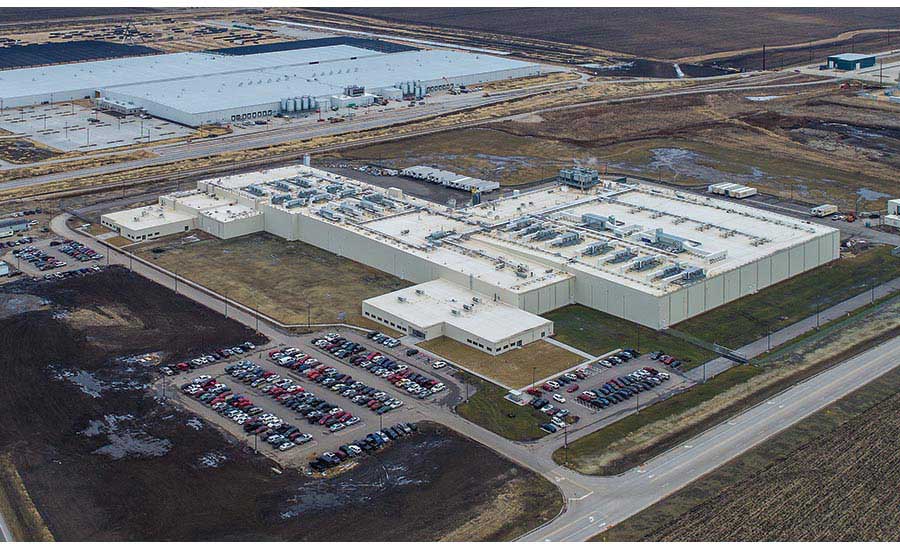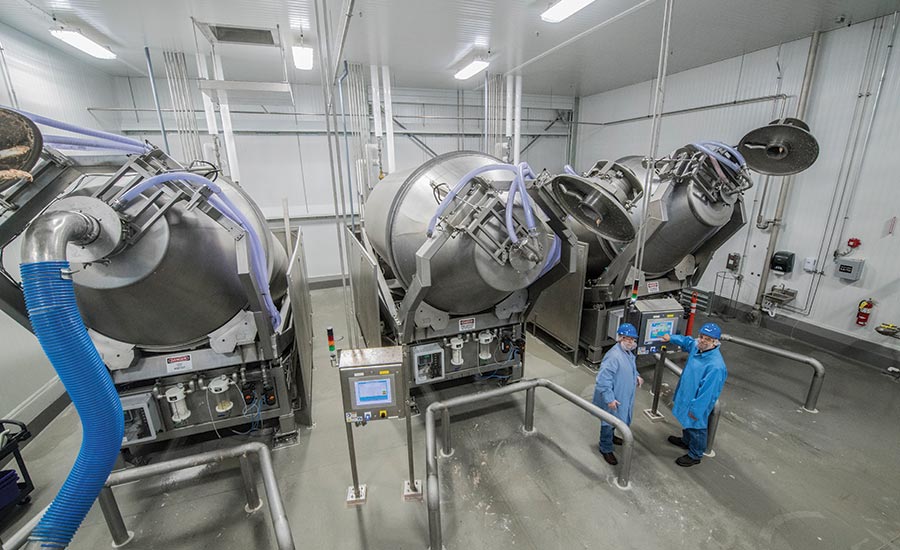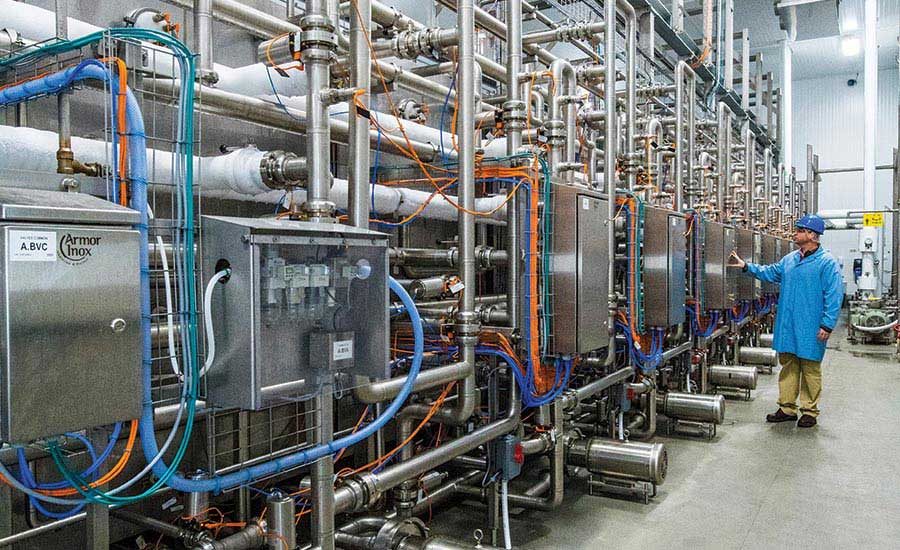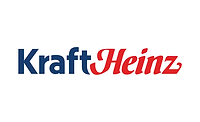The winner of Food Engineering’s 2019 Plant of the Year award has been declared. Click here to find out more!
When Kraft Foods Group and H.J. Heinz Co. merged in 2015, the combined two companies created what is now the fifth-largest food and beverage company in the world.
Article Index:
Since its inception, Kraft Heinz has been working on executing its Vision: To Be the Best Food Company, Growing a Better World. Always looking for opportunities to drive efficiency in order to reinvest in the growth of its brands and businesses, the company has invested more than $1.5 billion over the past couple of years to upgrade its global manufacturing facilities—all to enhance its capacity for innovation and product quality. And an important step in this process was to create the first greenfield construction project since the merger’s completion. What resulted from this $225 million-plus investment is the new 382,000-sq.-ft. facility, located on 70 acres in Davenport, Iowa, to produce Oscar Mayer deli meats.
The project, completed by Gray Construction, was an ambitious one, with groundbreaking in March 2016, steel framing erected in August 2016 and the first saleable package of product produced on June 13, 2017.
“We’re now concentrated on ramping the plant up,” says Rob Cubbage, plant manager for the new Davenport facility.
With its innovation in process design and packaging execution, use of advanced automation and extreme emphasis on food safety, the Davenport plant is a true state-of-the-art facility—one of three such new Kraft Heinz manufacturing plants upgraded in 2017. And this Iowa factory produces a range of Oscar Mayer products that are distributed across the United States.
“We believe that our brands—including Oscar Mayer—are the key, long-term competitive advantage in our industry,” says Michael Mullen, senior vice president of corporate & government affairs at Kraft Heinz. “Perhaps the biggest challenge our industry faces these days is the need to continually adapt to rapidly changing consumer preferences, making sure our brands live up to their full potential. With a strong stable of iconic brands like Oscar Mayer, we’re able to build brands that position our global product portfolio to grow and to win with consumers, both today and tomorrow.”

The greenfield 382,000-sq.-ft. Kraft Heinz facility, completed by Gray Construction, is located on 70 acres in Davenport, Iowa.
Food Plant Facts
Groundbreaking date:
March 2016
Date opened and functional:
June 5, 2017, first saleable package produced; reaching full production in 2018
Capital spent:
More than $225 million
Size:
382,000 sq. ft.
Number of people employed:
When fully staffed, 700 full-time hourly employees
Number of processing lines:
Total of 12
Total processing capacity:
2.8 million lbs./wk. and 0.8 million lbs. Lunchable meats
Products:
Oscar Mayer Deli Fresh, Deli Selects, Naturals, NAE (No Antibiotics Ever), Subkit and Lunchables/P3 meats
Storage capacity:
Buffer and dry warehouse = 80,000 sq. ft.
Plant history, construction and capacity
The journey of this new plant started all the way back in 1872, when a Kohrs plant was built in Davenport on the Mississippi River. In 1946, Oscar Mayer purchased this facility from Kohrs. During the 1990s, when Kraft was restructuring its manufacturing needs around the country, more production was transferred over to the Davenport plant.
“It’s always been known as the ‘can-do’ plant,” says Cubbage.
From 2001 to 2013, the plant specialized in making the then-newly launched Oscar Mayer Deli Fresh deli meat line, being one of only two facilities producing this product. However, due to the age of the facility and the company’s extensive review of its North America supply chain footprint, it became clear a new facility was needed to produce a variety of products, including Oscar Mayer Deli Fresh, Deli Selects, Naturals, No Antibiotics Ever (NAE) and the meat packaged in Lunchables. However, Kraft Heinz wanted to keep the new plant located in the Davenport area to take advantage of the existing supply chain and workforce.
“Since the 2015 Kraft Heinz merger, our North American Integration Program has given us a fast start in our journey to become the most efficient operator in our industry,” says Mullen. “Over that time, in North America alone, we’ve made more than $1 billion of capital investments to modernize and consolidate over 100 production lines.
“In Iowa and around the world, we’ve invested to win in both product quality and reaching our consumers. Since the 2015 Kraft Heinz merger, we’ve invested millions to deliver the quality our consumers are asking for and expect. We’re constantly researching, developing and launching products that reflect consumers’ tastes and cultural trends. That means evolving our iconic brands like Oscar Mayer, leveraging their strong equity to meet today’s consumer preferences around fresher, more natural products and convenience.”
Gray Construction was initially brought in to design and build the facility, but after construction began, Kraft Heinz wanted the project to have a building-and-process integrated approach. Therefore, Gray also conducted the process installation to streamline operations at the new plant.
One of the more unique aspects of this facility is the full separation between the raw and ready-to-eat (RTE) sides, which came about through Kraft Heinz’s emphasis on its highest priority—food safety.
“Because Kraft Heinz wanted to keep the raw and ready-to-eat separate, from a construction standpoint, we had to think in terms of room pressurization and make sure we didn’t cross-contaminate,” says Ryan Allen, assistant project manager at Gray.
There is only one wall that separates the two production areas. A corridor does exist between the two sides, but only a few authorized personnel have access to it. A high level of security is employed to keep this corridor locked down, and as a result, it is very rarely used.
“When you talk about keeping that line separate, all of that has to be designed into the building plan throughout the process,” says Allen.
There are two employee entrances, one for RTE workers on the northwest side of the building and one for raw, which is on the northeast side. No employee from the raw side is allowed over to the RTE side and vice versa. Employees from each side are kept completely separate, with separate entrances, office spaces, breakrooms and locker rooms.
Positive pressurization of the process areas is used to ensure exfiltration is controlled away from the product. Clean-in-place and clean-out-of-place capabilities and equipment are integrated into the entire facility.
Also, building elements, such as the LED lighting, HVAC and fire protection fixtures, are positioned away from being directly above exposed product to avoid contamination. Additionally, there is a walkable ceiling to keep the production areas clear.
“For the equipment platform on the walkable ceiling, we added an additional steel structure to support some of the vacuum pumps and other equipment that are used for the process in order to keep them out of the production space,” Allen says.
Even though the plant is operating three shifts Monday through Friday with some Saturdays and is well on its way to reaching its full capability of processing 2.8 million pounds per week, the construction on the facility hasn’t yet stopped. Before the building was even completed, the plant was expanded by 5,000 sq. ft. to accommodate the new “No Antibiotics Ever” line.
Raw processing side
When shipped to the plant, raw materials are received into a refrigerated storage area. The product flows across a hallway into one of the two identical injection rooms. During our visit, turkey breast was being processed and had been shipped from Kraft Heinz’s only slaughter plant located in Newberry, SC.
The meat, or in this case, turkey breast, is conveyed up to a platform, through a metal detector and injected with brine that includes food-safe ingredients and flavorings. The breasts are then macerated, with the muscle torn up to accept the flavorings and to foster protein extraction.
The prepped breasts are then screw-conveyed into a cart. If the recipe calls for ground meat or trim, then that, too, is added to the cart to total a 15,000-lb. batch. This cart is then moved by rail into the next room containing tumblers. The plant has a total of 14 tumblers, but does have room to add more if needed in the future.

The cart stops in front of a tumbler, then is vacuumed transferred into the glycol-chilled tumblers. According to what the certain recipe calls for, the batch can be tumbled for five to eight hours in order to reach the flavor desired and protein extraction needed for binding. The product is kept at 30°F the entire time this process is happening.
This protein extraction process step is a major improvement over the traditional method.
“Usually, that takes up to 24 hours to achieve, and this process is capable of achieving it in as little as five,” says Craig Smith, operations lead, who’s been with Kraft Heinz for 35 years. Smith says R&D has been onsite working to modify the recipe formulas in order to make the product work with the new process.
When the product is ready to come out of the tumbler, it travels across the hallway to one of three stuffing rooms. Here, the mix is vacuum-pumped into casings that are called “sticks.” Each stick must weigh 40 lbs. and be of a certain length, so the batch cooking process remains consistent. The sticks are washed to clean away any outside product and travel into the Armor Inox thermal processing system room.
In this room, 15 sticks are conveyed to trays and then automatically are moved to processing tanks, where 15 layers are stacked on top of each other. When that is achieved, a lid is automatically put on top of the tank, and the process water is heated in stages to fully cook the meat. After it is cooked, then it is chilled down. The whole cooking and chilling process takes about nine to 12 hours.
“We don’t move the product during the cooking and chilling process—only the fluid changes,” says Clint Walters, production manager on the raw side.
Smith says having the three stuffing rooms is important to continuously feed the thermal processing system.
“If one room is shut down for cleaning, we just have to switch the conveyor line to a different room,” Smith says. “That way, we can keep the oven running.”
The process is fully automated, with only a very few employees supervising 22 tanks in the room.
“From a food safety standpoint, you don’t want workers to touch [the product],” says Walters. “From an ergonomics standpoint, you don’t want employees hurting themselves carrying all that weight around.”
The plant also processes the meats for Lunchables, although it does not do any of the final slicing or packaging. This product is processed in a similar way to the Naturals line and other products produced at the plant, but instead of batches consisting of 15,000 lbs., they are in 7,500-lb. batches. The product stays in stick form and is shipped out to the other packaging plants, such as the Kraft Heinz plant in Garland, Texas.
However, for the Naturals product line and others, these sticks are transferred to the RTE side.
Ready-to-eat processing
One wall is shared between the raw side and the RTE side, with only small holes in the wall to transfer product over the threshold. Once the product in stick form enters the RTE side, it goes into one of two drop rooms. Then, the product is sent to one of the three holding coolers or can be sent to the slicing rooms directly. There are 12 slicing lines in nine separate rooms that can accommodate different-sized packages to produce the 75 SKUs the facility churns out.
For this plant, five new slicing lines were purchased, and the rest were brought over from the older Davenport plant. The lines are divvied up into nine rooms, which are separated from the adjacent secondary packaging room.
The target temperature of the stick meat is 32°F. During the slicing, temperature readings are periodically done to ensure food safety.
A checkweigher weighs the sliced meat and kicks out amounts that are over or under the package’s specified weight before they are automatically placed in the packaging trays. Once the product is in trays, two employees check that all meat is properly inside the packaging to ensure no product wedges where the lid film is to adhere, which could compromise the seal.
Over these rooms are walkable ceilings that contain all the controls and utilities, and nothing is located directly above the exposed product or sealed packages. Because the product is exposed in the slicing rooms, no wood or pallets from the secondary packaging area are allowed. Also, to minimize changeover, a jumbo roll for the packaging film is used. To minimize any contamination risks, this roll is brought in on a hoist from the secondary packaging area.
Before entering the secondary packaging area, the lid film is trimmed, and a vacuum sucks off all the excess. The trays then are stamped with date and time codes by inkjet printers and are weighed again to be sure the package meets the label weight.
The packaging lines produce 30,000 to 50,000 lbs. each day, depending on the types of packaging they are filling, whether it is for base, family or mega-size packages.
“We’ve built in a lot of flexibility in our packaging line changeovers, so a lot of our lines are able to run almost any item or package size,” says Wendy Nugent, RTE production manager.
The packages are conveyed into the separated secondary packaging area, which contains all the automated case packing and palletizing equipment. Nine of these lines are Aagard case packers and can switch on a dime, says Nugent. For instance, when one retailer wanted to reduce the case size from 12 to eight counts, she says the plant was able to make the switch over a weekend.
The product is inspected by checkweighers, metal detectors and X-ray machines. Also, a 2D bar code scanner scans the top and the bottom to check the labels. Box labels are also checked in this manner. This multi-step and equipment inspection process was important for Kraft Heinz to ensure its consumers receive the product they are buying.
“Mislabeling is one of the top reasons for recalls,” says Cubbage.
The plant is implementing track-and-trace controls on the back-end of the process. However, Smith says there are plans to implement that type of scanning on the raw side, as well for total batch-controlled processing.
The palletizers stack the formed, filled and sealed boxes onto pallets, which are then transferred to the buffer warehouse, which has the capacity to hold seven to eight days of product, although typically, product does not stay in the warehouse longer than three days.
An ‘obsession’ with quality
Leaders at Kraft Heinz stress the company’s unwavering commitment to quality.
“In fact,” says Senior Vice President Michael Mullen, “it’s one of the five values of our company. From our CEO Bernardo Hees to line operators in our factories, quality is an obsession.”
Mullen says that’s why the company continues to make significant capital investments, like those at the new Davenport plant, focused on the end of the line for detection and risk avoidance. Plant-level rituals and routines allow Kraft Heinz to leverage these investments and fundamental safety rules in its factories around the world. It’s one reason, says Mullen, that the company achieved an important and impressive quality achievement in 2017—a year with zero product recalls across the globe—a testament to its “obsessive focus” on process, procedures and employee training.
By staying in the Davenport area, the plant is able to benefit from having an established supply chain, as well as a ready and skilled workforce. Cubbage says it has been able to leverage the workforce from the existing plant to this plant, making the production startup that much swifter.
Click here
to see our Food Plant of the Year photo gallery
Plus, production is easier and more efficient to complete, because much of the material handling has been cut out. Due to the innovation in the cooking and chilling process with the Armor Inox tanks, what is done in one step at this facility had to be done in three steps at the older facility.
Another improvement is the reduction of the amount of ammonia used in the plant, which is only 33,000 lbs. To achieve this, a two-stage refrigeration system is used to protect both the workers and the product. Ammonia, the primary refrigerant, is kept mostly in the mechanical spaces of the facility. Glycol is the secondary refrigerant that is used throughout the plant.
Ammonia compressors are used to achieve three different temperatures within the plant: 30°F, 18°F and -5°F. There are only two spots where ammonia is used in direct process cooling: the pickle room and the ice maker. Everywhere else, glycol is used to cool, via eight ammonia compressors.
“To have all new piping in an ammonia system, it’s a good thing,” says Jeff Rushing, maintenance manager, about the powerhouse.
Rushing says Kraft Heinz requires the plant to conduct a process safety management audit every three years. This is to ensure the safety and health of the workers, as well as to preserve the mechanical integrity of the new plant.
Cleaning and continuous improvement
Even though many of the workers from the older plant were transferred to this plant and were prepared to start working their lines the first day, there are some big changes that have have been made to improve efficiencies.
“We’ve moved the sanitation process from a third shift, which is typically the shift where you have your newest employees and highest turnover,” says Cubbage. “Now, we do all the sanitation activities on a day shift with the crew that runs the line.”
This move enables the whole crew to take ownership of their line. Since it is the crew that is responsible for starting up the equipment and using it throughout their shift, they take even greater care in the proper cleaning and care of it.
“It’s the crew that cleans it, that assembles it [and] that starts to run it, and, typically, the day shift employees are your most experienced and reliable employees,” says Cubbage. “So, we’ve seen a lot of success in improving our sanitation speed and efficiency, as well as the uptime of the equipment.”
As for continuous improvement activities, the plant’s management utilizes a daily direction setting (DDS) structure, where the line’s team meets every day to talk about safety, quality and the schedule for the day, such as the products that they will be running.
Line technicians also have a separate meeting with Wendy Nugent, RTE production manager, to go over any challenges and requirements to solve any problems.
“With all the new lines coming up, we’re working on 5S,” says Bennett Masden, continuous improvement manager. This workplace organizational program, based on five Japanese words, concentrates on keeping the workspace organized for efficiency and effectiveness. Part of the program emphasizes keeping tools and equipment in their place. As part of this effort, painted marks visible on the floors in the slicing rooms indicate where certain equipment should be located and kept.
“This is to reduce clutter,” he adds. “Also, we’re working to increase efficiencies and reduce product travel time.”
For future areas of improvement, the plant is working to implement a cleaning, inspection, lubrication (CIL) program with the operations team, which is in step with moving workers to a total line ownership model. Within this program, they are beginning to tackle centerlining, a methodology used to reduce product and process variability and increase machine efficiency in manufacturing and other industrial processes.
“Much of that has already been provided by our vendors, such as home settings and best settings. We’re making sure we’re adhering to those,” says Masden.
At all its factories, Kraft Heinz implements “gold standard” measures designed to ensure industry-leading, consistent quality in its plants—working the same way everywhere. It’s about making needed capital investments—and doing the hard work day in and out to consistently excel.
Room to grow
Even though the structure facilitates a one-way product flow, the building layout is a bit unusual. However, as Cubbage explains, the strange shape of the building was chosen for a reason—expansion.
“We knew from the beginning we wanted to grow the facility,” says Cubbage. “There is space to add powerhouse, warehouse and packaging capability to support up to five more lines.”
The facility was expanded even before it was completed. This expansion was to accommodate the new No Antibiotics Ever line, which Cubbage and Smith both believe will become a bigger part of the production at the plant. Even though the plant doesn’t use any ingredients classified as allergens, it still has strict ingredient controls. And with producing NAE, they have to treat that product almost as if it were an allergen.
“That’s why we built the expansion: to accommodate that product line,” says Smith.
This expansion’s estimated completion date is September 2018.
It’s all part of Kraft Heinz’s ongoing investment in quality-related enhancements. With 83 factories around the world, on every continent except Antarctica, the company sees its state-of-the-art Davenport plant as a competitive advantage as it navigates the changing consumer landscape and ensures that iconic brands like Oscar Mayer remain relevant for years to come.
See more Food Plant of the Year content










